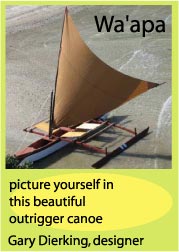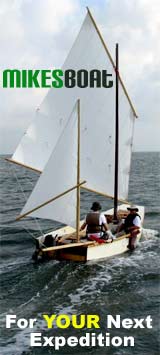Designed by Walter W. Haertel
The little boat shown in the drawings was designed after a careful study of the needs of a hull for use in conjunction with the outboard motors now on the market. The result combines a pleasing appearance and sturdy construction with speed and ample carrying capacity. Incidentally, for entirely satisfactory use with an outboard motor a boat should be designed for the purpose.
The transom is made of 11/4,-in. oak reinforced with oak cleats and fastened to the keel and the inwales with especially long knees. These knees take up the vibration caused by the motor and distribute it throughout the boat instead of the transom being required to absorb all of the vibration. The frames are of oak 7/8-in. by 2-in. spaced 24-in. on centers and the planking is of 1/2 in. cypress. The gunwales and inwales are 3/1, x 11/2-in. oak through-fastened to the planking and the frames.
 |
The seats and the floor, the latter in three sections and removable, are of cypress. The entire structure of the boat is thoroughly well fastened together. The after seat is built so that the person operating the motor may sit on either side while steering, which is a much more comfortable arrangement than the usual cross seat without wings. Six or seven people may be accommodated on the' four seats without crowding and the stability of the boat makes her safe for fishing when it is necessary to move around sometimes. The hull lines make an easy boat to row should this be necessary, and the after sections have been kept beamy to give more bearing and to keep the bow from rising too much when only one person is using the boat, who must of course, sit in the stern to handle the motor. Several boats of this model have been built by the designer for experimental purposes and they have proven very dry in a choppy seaway, as the flare in the forward sections tends to throw off spray. They ride easily and steadily, which is desirable for fishing purposes. The boat is very simple to build and anyone who is familiar with the use of ordinary carpenter's tools can make a creditable job of the construction. The cost, if all the work is done by the prospective owner, will be from $50 to $60 complete, depending upon local prices of lumber and other materials. The designer will gladly answer any inquiries from readers of MOTOR BOAT who want to build, or furnish full size if they are required.
 |
It is not often that a canoe is used for extensive cruising on the open waters of the Atlantic, most sailors preferring something more in the way of comfort and ability. Yet this little boat whose plans are shown here, successfully made a cruise from Grenada, one of the Windward group of the West Indies, up to St. Lucia and Martinique, many of the runs being from 40 to 50 miles in length across the open water between the various islands with nothing to leeward for 1,500 miles.
She was built, and sailed on this trip, by Mr. F. A. Fenger, who designed the 38-foot cruising ketch which we published some months ago, and which the readers of Yachting may recall. She was designed especially for this trip by her owner, and was 17 feet long, with a beam of 39 inches. She is shaped very much like a saucer with plenty of flare, well-rounded overhangs, and a powerful midship section, wherein lay the secret of her ability. Her owner says of her: "She weighed only 143 pounds, half of which was embodied in her middle third. With her crew and the heavier part of the outfit stowed in this middle third, she was surprisingly quick in a seaway. With a huge breaking sea coming head on, her snoopy bow would rise up through the foamy crest, while her stern would drop into the hollow behind, offering no resistance to the rising bow. True to her antecedents, I found later that in a heavy sea way she would dodge and twist and turn like a cow pony, and when those fierce tropical squalls blew down she would lie to with her mizzen up, like a tired gull resting in a gale -wherein lay another secret. She had no rudder, and when lying to in a squall and going astern, there was consequently no afterplane to interfere with her backward progress, so that with her centerboard well forward, and her acting sail plan well aft she centered her self into the wind's eye like a weather vane.''
 |
The boat has three compartments, all of equal length, the center one being a cockpit, and the two end ones being watertight, accessible through watertight hatches. The volume of the cockpit was diminished by one-half by means of a watertight floor raised above the waterline; the cockpit was long enough for a man to stretch out at full length when it was necessary to sleep on board.
She was planked with three pieces of Spanish cedar on each side, one-quarter of an inch thick. The seams where the planks met were beveled together and followed on the inside by a light stringer one-half inch wide and an inch and a quarter deep. This made a very strong and light construction.
Her rig consisted of two fore-and-aft fan sails of the canoe type and a small jib. They were rigged on single halliards and could be hoisted, reefed and furled from the cockpit. They were home made of Wamsutta unbleached cotton. The three sails had an area of 90 square feet, and, together with their spars and gear, weighed only twenty pounds.
The boat carried no rudder, the steering being done by handling the main sheet. Mr. Fenger says, regarding this feature: "Steering was accomplished through a novel construction of centerboard and well in which the board rolled forward and aft on sets of wheels in a track, and could therefore be set in any desired position. Thus I could in practice place the center of lateral resistance of the canoe's underbody exactly under the center of effort of the sails, with the result that on a given course the canoe would sail herself. Small deviations such as those caused by waves throwing her bow off the course and sudden puffs that tended to make her luff were taken care of by easing off or hauling in on the mainsheet. And speaking of puffs and luffing, it is interesting to note that in the absence of the rudder plane aft, which at times is a considerable drag to a swinging stern, this type of canoe eats her way to windward in every squall without losing headway, executing a 'pilot's luff,' and in puffy weather will actually fetch up slightly to windward of her course, having more than overcome her drift. She was no new and untried freak, for I had already cruised over 1,000 miles in the predecessor of this canoe, the only difference being that the newer boat was nine inches greater in beam. On account of the increased beam it was necessary to use oars instead of the customary double paddle."
[Designer Unknown]
|











